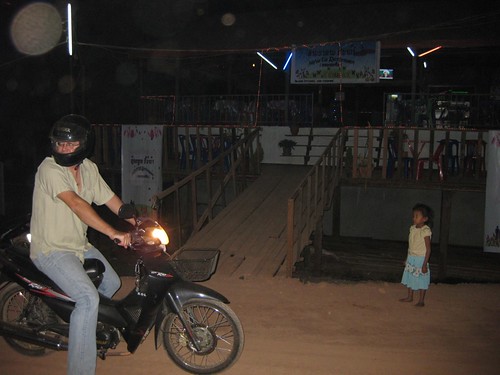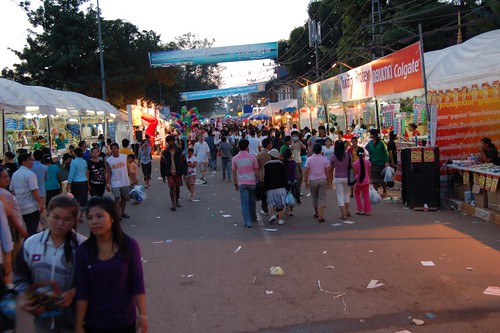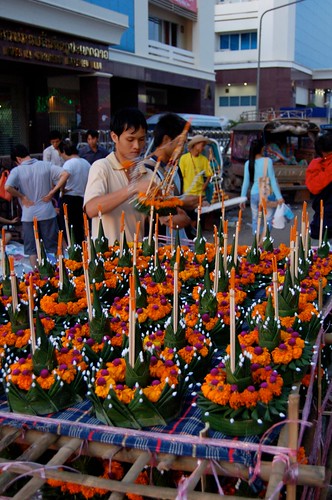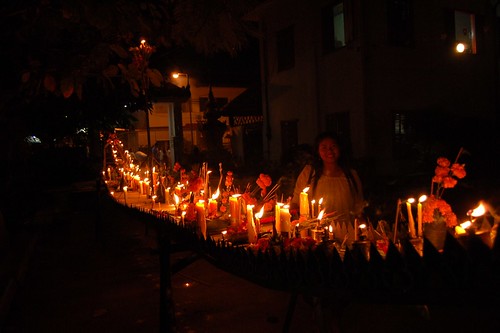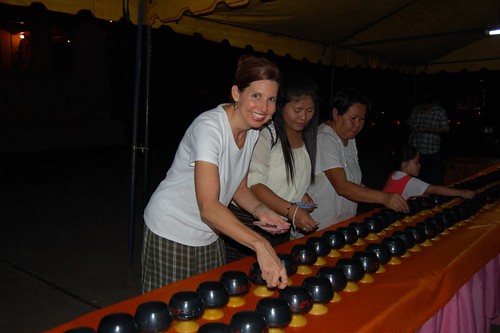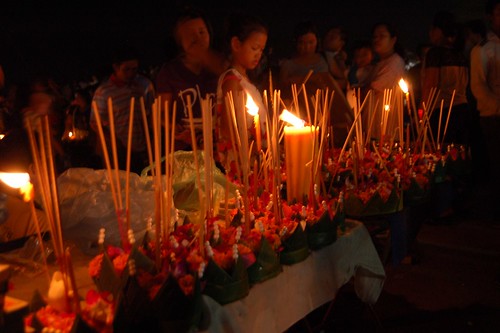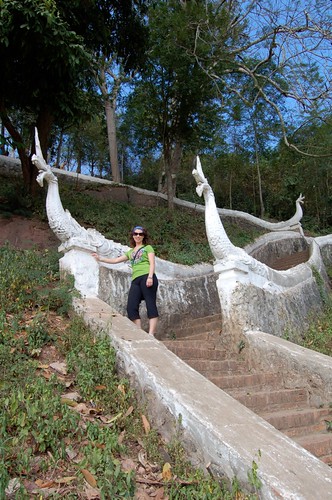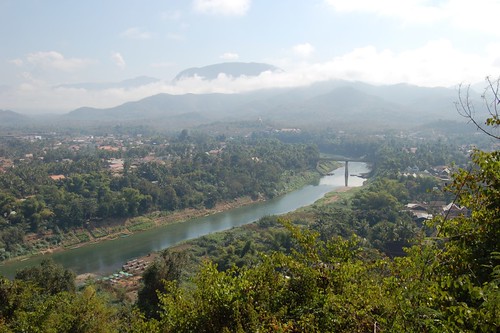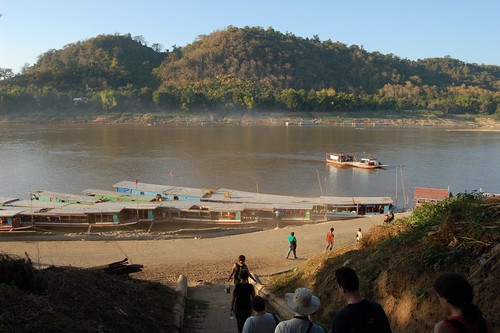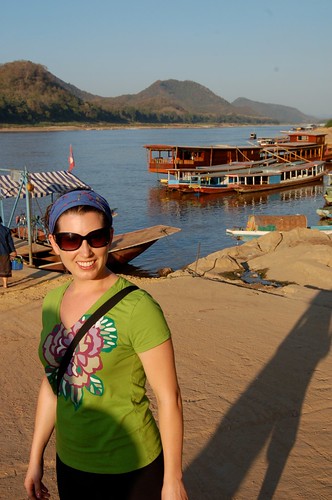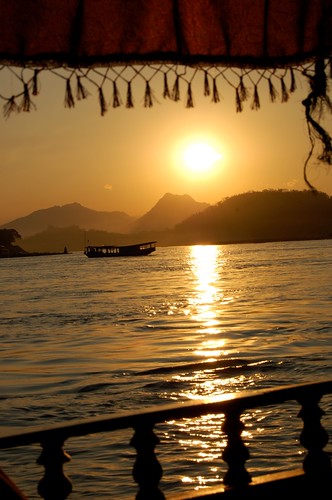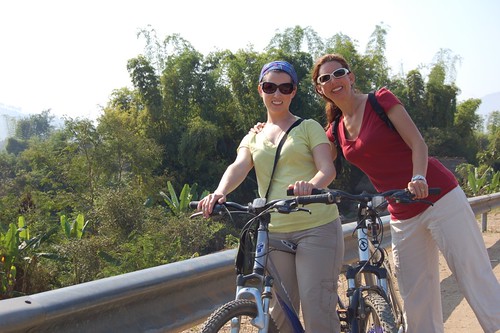I am wayyyyy behind on blogging. Here’s my final post about Laos (unless I get overcome by another wave of nostalgia).
Tag Archives: Mekong River
Family Night – NeNaTa Restaurant
You can make a lot of safe assumptions when you peek in a Vientiane restaurant to check out the clientele. Mostly Lao people? The restaurant probably serves cheap, delicious, spicy Lao food; the menu most likely won’t include English descriptions of the dishes; and if you don’t speak Lao, you shouldn’t try to place special orders. Mostly expats? The restaurant probably tailors its dishes to our less adventurous palates; the menu likely features illustrations and/or sometimes-decipherable English descriptions; and you can usually find someone who understands your Lao/English/Body Language special requests.
That’s why we felt a bit sorry for the couple who were strolling along the Mekong River, saw our group hanging out at NeNaTa Restaurant on Wednesday and clearly thought to themselves, “Hey if those white people are eating there, it must cater to westerners.”
Ha! Little did they know that it was Family Night! As usual, we ventured out to find a local joint in our neighborhood. It was my turn to pick the place, and I chose this riverside restaurant that you can’t access from the main road. We had to maneuver our motorbikes past the barricades blocking the dirt road that runs along the Mekong from our village to downtown Vientiane. The road is under construction as part of a massive flood-management project. NeNaTa Restaurant is the only eatery along this stretch of road, and we were the only customers (until those other poor saps showed up).
As expected, the menus were devoid of English, and the staff were friendly but monolingual. I called our Lao friend, Lae, and handed the phone to the waitress (cook? owner?). Lae prattled on for about 5 minutes, later explaining that she told the woman foreigners don’t like MSG, bones, blood, animal faces, or anything with a strong smell. We had no idea what she had ordered for us, but it all turned out to be delicious: steamed rice with grilled fish, stir-fried vegetables, deep-fried shrimp, a seafood medley, and stir-fried chicken and veggies.
I don’t know how that other expat couple fared.
Here are some photos.
The “parking lot” was behind the elevated restaurant, which backed up to family garden plots.
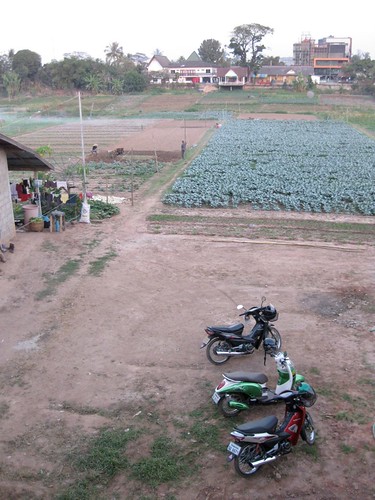
The front overlooked the Mekong, where locals hung out among the construction materials.

The “family”: Tony, Nikki, Carol, and Jon.

As we enjoyed the sunset, our view was suddenly blocked by a truck and forklift transporting paving stones.

Sometimes you just gotta laugh.
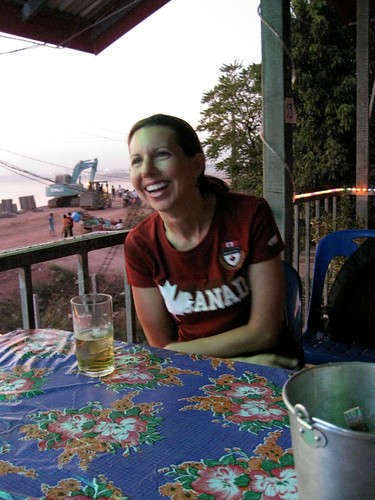
This guy found his own riverside bliss.
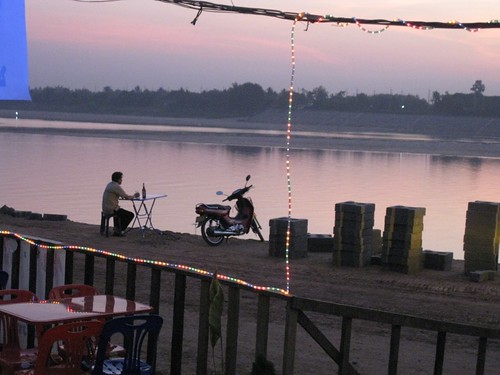
I’ve got to remember to buy one of these lovely toilet paper dispensers for our summer picnics in Michigan.
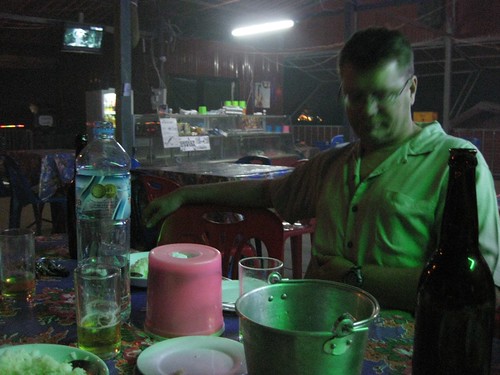
Xin Nian kuai le!
With a significant population of Chinese living and working in Laos, our little city saw its fair share of Chinese New Year festivities. However, nothing will ever compare to celebrating Chinese New Year in China. As we kicked off the Year of the Rabbit, Tony and I were feeling a bit nostalgic for the real thing. Luckily, Vientiane has a newly renovated Chinese temple at the Mekong riverfront.
According to the website Chinatownology, this is a Teochew temple called Fu De Miao, which was first dedicated in 1968. The area around the temple was previously a muddy embankment but is now a park, constructed as part of a $37 million flood management project funded by a loan from Korea.
We visited the temple recently and liked it immensely. The only thing missing was deafening fireworks.
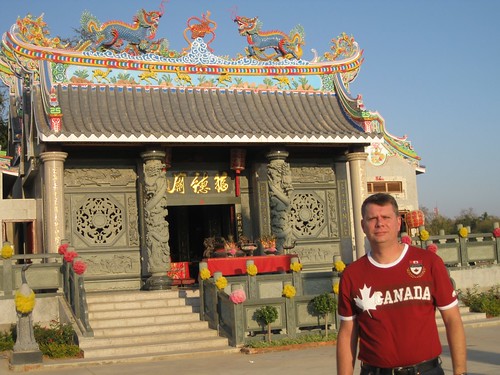
Loi Ka Thong – looking for peace in all the wrong places
One glimpse of the crowds at last year’s Boat Racing Festival was enough to send me straight home, where I watched the dragonboat races on TV. Later I regretted being such a coward. I vowed to step out of my comfort zone this year to experience one of Laos’ most highly-anticipated celebrations.
The holiday, which is tied to the lunar calendar, fell on a weekend this year. The boat races were scheduled for Sunday, and the Buddhist ritual of Loi Ka Thong would take place Saturday night.
I arranged to join some Lao friends for Loi Ka Thong. Websites, such as Laos Guide 999, set the stage for a tranquil, holy tradition.
Boun Awk Phansa is the last day of the Buddhist lent. It occurs in October, three lunar months after Khao Phansa on the 15th day of the 11th month of the lunar calendar. It is a day of many celebrations, most notably the boat race festival held in Vientiane.
On the first day at dawn, donations and offerings are made at temples around the country; in the evening, candlelight processions are held around the temples and it is the celebration of lai heua fai or Loi ka thong, when everyone sends small lighted ‘boats’ made of banana stems or banana leaves decorated with candles and flowers down the rivers.
These are said to pay respect to the Buddha and to thank the mother of rivers for providing water for our lives. Some believe that the lai heua fai procession is an act to pay respect to nagas that lives in the rivers, while others send the lighted boats down the river to ask for blessing and to float bad luck of the past year away enabling the good luck to flow in. Most towns with a river bank nearby will engage in this lovely ceremony. In bigger towns there are also processions of lighted boats, and the ceremony is more popular especially among young romantic couples. Villagers who live far from rivers set up model boats (made of banana stems) decorated with flowers and candlelight, while others simply light up some candles in front of their houses and do their little prayer wishing for good luck. This colorful rituals have been carried on by Lao people for thousands of years.
We were going to visit a temple, purchase a banana-leaf Ka Thong boat, join the procession to the Mekong and set sail our little boats after blessing the river and asking forgiveness for any eco-wrong-doings.
But first, we had to meet for Indian food in the heart of the festival chaos. The river road in downtown Vientiane was cut off from traffic and lined with stalls selling all sorts of wares usually purchased at a supermarket (and at the same prices). Massive speakers faced off, blaring what I can only assume were the qualities of the shampoo, toilet paper, cooking oil, or other products for sale at that particular stall. Vendors without a swanky audio system used static-y megaphones to promote the free samples, which flowed like … well, like juice, milk, whiskey, beer, soda and hand lotion. Complementing the cacophony, loudspeakers pounded out a steady bass beat with no discernable melody.
Tony and I parked where we always do, a few blocks from the action at Nam Phu Fountain, and then dove in to the melee. At this point, the river road was crowded but not unbearable. With so many storefronts blocked by the stalls, we occasionally had to pause to get our bearings. Finally we found the restaurant, Nazim, and scoffed at the option to eat outside. We eagerly plopped down at an indoor table, happy for a break from the noise (although we really couldn’t escape from the pulsing beat, which created ripples in our water glasses and reverberated through our bodies).
Soon we were joined by Lao friends Lae and Mai (and Mai’s friend, Khanha), as well as our school librarian, Jeannete, and her husband, Basim. I enjoyed the meal and the company, but I was itching to experience Loi Ka Thong.
Jeannete got a call during dinner from some cyclists riding through Laos. “We’re here!” they told her. She and Basim participate in an online organization that finds spare beds for people bicycling around the world. So they had to dash home. Tony also took off (and then came back to retrieve his keys, which he’d left on the table). Finally, the rest of the girls were ready to go.
I made the classic expat faux pas of assuming that because my friends were Lao, they certainly must know how this tradition works. Unfortunately, after wandering aimlessly for a while, I discovered that was not the case. Lae admitted she hadn’t participated in Loi Ka Thong since she was in high school. Mai said her family lived too far from the river, and they only had one bicycle, so participating in the ritual at the Mekong wasn’t feasible.
We ducked in to Wat Ong Teu, only to find we had missed the temple’s procession. Several monks were sitting behind a large table lined with metal bowls. Mai explained that you make a donation, collect a little plate of tiny coins and then drop one coin in each of the 99 bowls to ask for blessings. Cool. Of course, I was chatting the whole time I did it, so I kept losing track of where I had dropped my coins. “Is it bad karma to skip a bowl or to drop in more than one coin?” I asked. They just laughed at me.
Back on the river road, the crowd had reached maximum capacity. We slowly shuffled upstream as the Mekong River – blocked from our vision by market stalls, inflated bouncy castles, towering loudspeakers, and thousands of other pilgrims – rushed past us in the other direction. We reached one access point to the river, where a mob had bottlenecked with their Ka Thongs. The thought of joining them made my heart sink.
Lae received a call from Addie, who told us to keep walking. “It’s much less crowded up by the Mekong River Commission,” she said. And so we did. As we stumbled along, Lae shouted to me, “Now you see why I never do this!”
Eventually, we caught up with Addie, and sure enough, there was room to breathe. Addie had made her own Ka Thong (and many more, which she distributed to family members), so the rest of us purchased some from a vendor. Then we walked across a muddy stretch, descended some steep steps, scrambled down large wobbly rocks to the river’s edge and stepped on to a slippery floating dock. With my long temple-appropriate skirt tangling around my legs, camera dangling from my neck and one hand carrying my Ka Thong like a pizza, I felt quite relieved to make it that far in one piece.
The girls helped me light the candles and a sparkler on my Ga Thong, and then we each took turns offering a blessing to the river and asking forgiveness before reaching down to release our little boats. The strong current immediately swept them away, and the lights quickly blended together in the darkness.
Dripping with sweat, shaking from the treacherous climb back up to the river road, and still reeling from crowd-induced anxiety, I thanked my lovely friends for sharing their tradition with me. It wasn’t exactly what I expected, but I had the same experience as thousands of Lao people on this holy day, and that’s exactly what I had wanted.
It’s still early, and the crowds are thin.
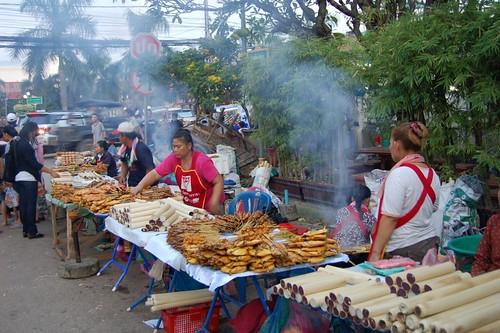
Back at the river road, it’s getting pretty busy.
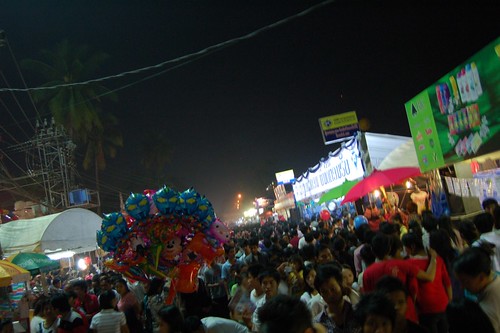
Finally, we meet up with Addie and enjoy a little elbow room.

Lanterns in the sky, Ka Thongs in the water.
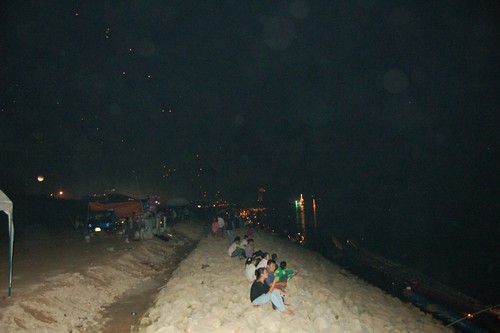
Mai says a little prayer before releasing her Ka Thong.
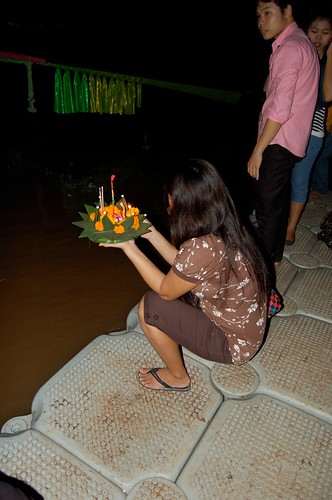
If you have a job that causes harm to the river, you must send out a bigger offering such as this.
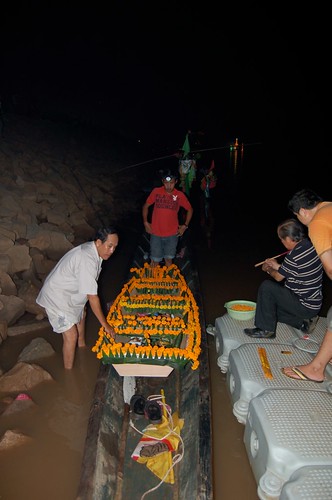
I couldn’t hold the camera steady on the bobbing dock, but I like this shot anyway.
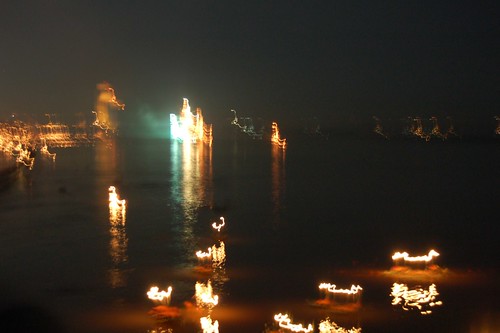
Luang Prabang – Taking It Easy
I’m sitting at a coffee shop in Luang Prabang, Laos, sipping yet another refreshing “soda maak nao” (soda water with lime). I had hoped for a fruit shake, but the power’s out all over town. No electricity = no blender = no fruit shake. Bummer. Megan is getting her daily massage. Until my banged up legs heal a bit (mementos of rock climbing in Krabi), I’m taking a hiatus from aggressive rubdowns.
We arrived here Saturday evening and took a stroll around town. It’s hard to believe we’re in Laos. The French, who landed in Luang Prabang in 1887 and refused to leave till 1954, left quite an architectural mark. Since the city became a UNESCO World Heritage site in 1995, many colonial villas, shops and offices have been converted to guesthouses, restaurants and art galleries. Located at the confluence of the Mekong and Khan rivers and surrounded by mountains, the town takes on a quiet vibe. Tourists rise early to snap photos of the monks collecting alms in the chilly mist, so mornings are a bit lively along the main boulevards. Then the clouds burn off, and everyone seems to take a long afternoon nap to escape the scorching heat. Cool breezes prevail after sunset, and the town comes to life again but in a gentle way with twinkly lights dangling from the trees.
Our first night in Luang Prabang, we went out for a casual dinner. Megan tried her first “laap,” a popular Lao dish of minced chicken and herbs, eaten with sticky rice.
The next morning, we followed part of a Lonely Planet walking tour, visiting a couple temples and then climbing up the 100-meter-high hill, Phu Si, to see the golden That Chomsi stupa at the top and to enjoy stunning views of the two rivers.
A pretty little spot on top of the hill.

Inside the little temple at the top.
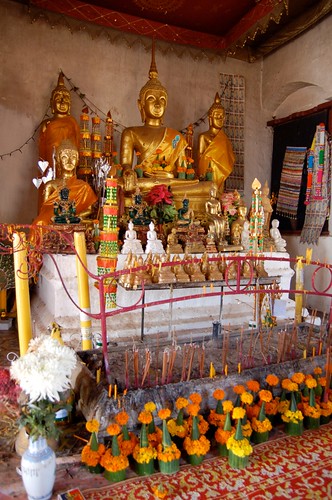
Buddha’s footprint. He must have been huge!
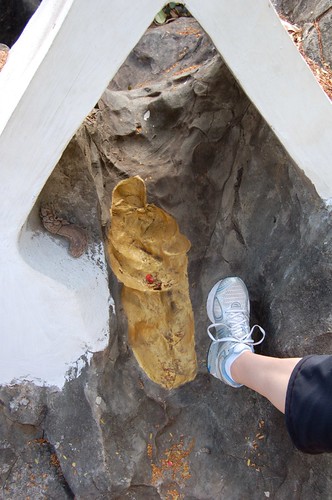
Great views of the two rivers. Here’s the Mekong:
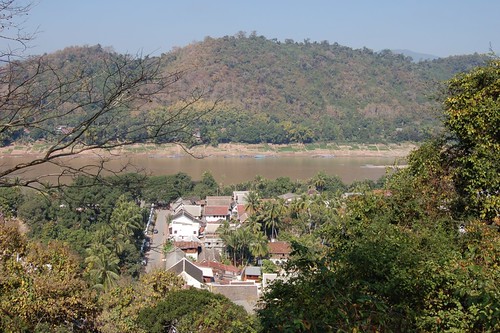
After lunch (and Meg’s daily massage), we jumped on a longboat for a little cruise on the Mekong. The riverbanks were bustling with village routines: ladies washing laundry, children chasing each other, farmers tending the crops and animals, workers building a boat, fishermen pulling in their nets, and monks strolling to and from the hillside temples. Around 5 p.m. it seemed everyone decided to take a bath. Mothers stood in waist-deep water to give the kids and themselves a good scrubbing. Men stripped down to their skivvies and waded in for a wash. Although other people on our boat took pictures, it seemed quite invasive. They must have been thinking, “Geez, can’t a person have a little privacy around here?” When the sun dropped behind the mountains, everything and everyone was bathed in a pinkish golden light. As our boat pulled back to shore at Luang Prabang, long lines of Lao people were waiting for the river taxi-boats.
This is what Megan has seen the most on this trip.
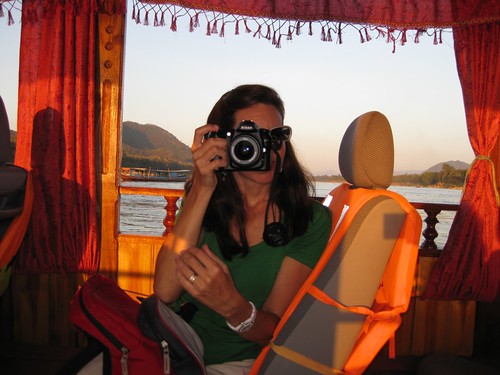
This is what happens when you ask Megan to take pictures. Sigh.
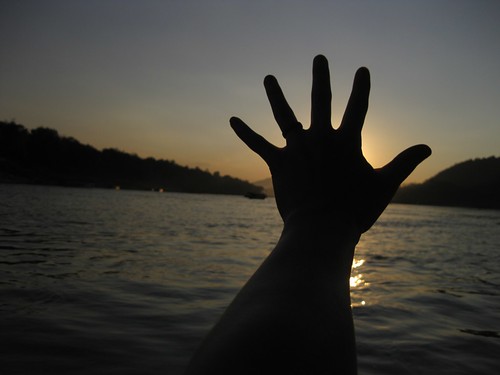
People waiting to catch the river taxis.
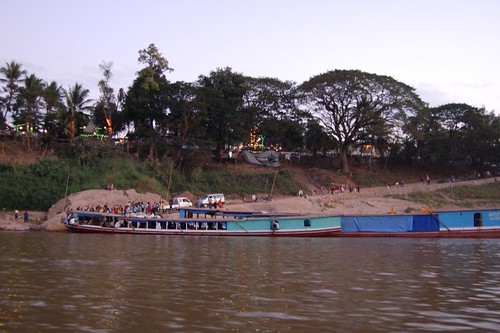
For dinner, we went to 3 Nagas, a posh open-air restaurant connected to a boutique hotel. The food was delicious, but even better was the ambience. I had made a reservation earlier in the day, so when we showed up, our outdoor table was marked by a banana leaf with my name written in silver ink. (The leaf said “Sharan,” but close enough, eh?) A tiny vase held a delicate white flower with spindly petals. White lights swayed in the trees, and vintage cars were parked on the street. It felt like a movie set.
Today, we rented bikes and cycled to the outskirts of town. Twice we turned off the main road and pedaled till we ran out of asphalt. Once we left the historic area, the city looked very similar to Vientiane. People doing their jobs, living their lives.
Back in town, we traded our mountain bikes for these cruisers and pedaled around the back alleys.
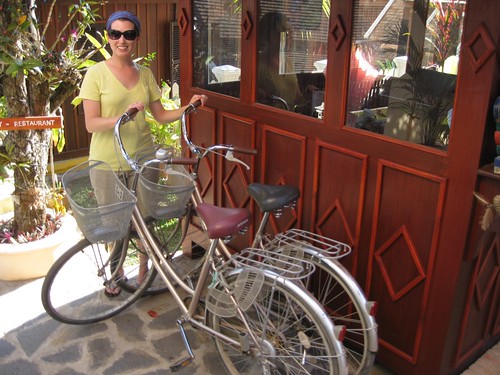
After our ride, we stopped for a coffee but that’s when we learned of the power outage. We parked the bikes at the hotel and went for a stroll, and then Meg headed for her massage du jour. (Turns out the massage therapist was falling asleep, so Meg cut it short and met me at the café!) So, I’ll just suck down the rest of this soda with lime, and we’ll look for diversions that don’t require electricity…

